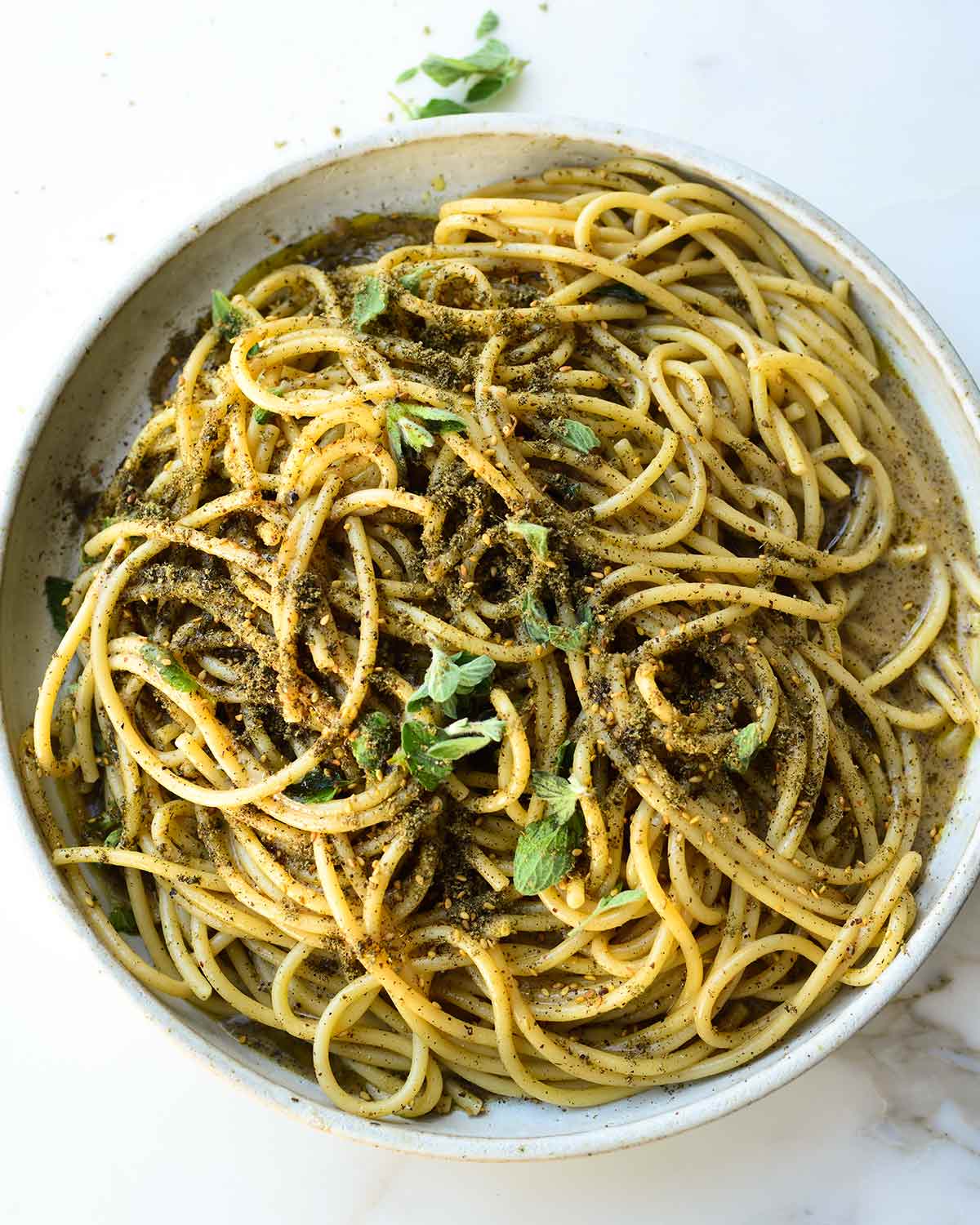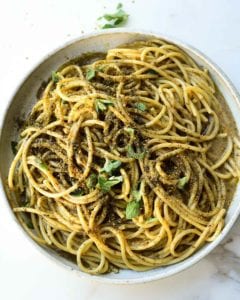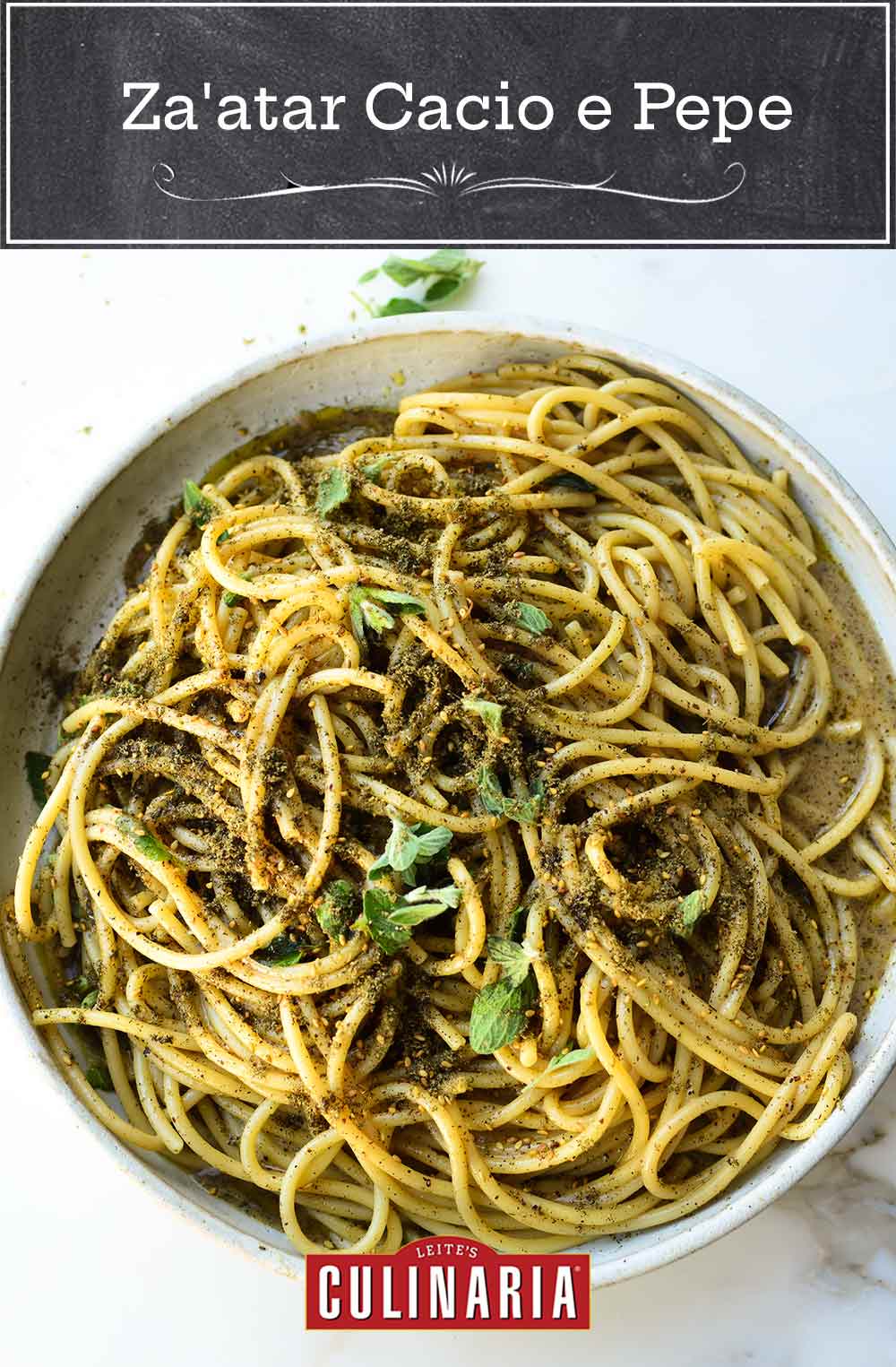
The line between one classic and another blurs in this za’atar cacio e pepe. Cheesy strands of pasta are embellished with more than just the classic pepper, taking an almost herbaceous lilt from the centuries-old spice blend.–Renee Schettler Rossi
*WHAT IS ZA’ATAR?
Za’atar is a Middle Eastern spice blend that contains thyme, sesame seeds, and sumac. Sumac has a lemony smack that’s pretty darn potent. The amount of sumac in a particular za’atar blend can vary dramatically, so you may want to play around with a couple different brands of za’atar.
Want to Save This?

Za’atar Cacio e Pepe
Ingredients
- 5 1/2 cups water, plus more if needed
- Table salt
- 14 ounces dried bucatini (or other long pasta)
- 4 tablespoons (2 oz) unsalted butter
- 1 tablespoon plus 1 1/2 teaspoons store-bought or homemade za'atar*
- 2 teaspoons freshly ground black pepper
- 4 1/2 ounces very finely grated Parmesan (about 1 1/3 cups)
- 1 ounce very finely grated pecorino (about 1/3 cup)
- 7 1/2 teaspoons olive oil
- 2 teaspoons whole marjoram leaves (optional)
Instructions
- In a wide saucepan over medium-high heat, bring 5 1/2 cups of water to a boil, then season with 3/4 teaspoon salt. Add the bucatini and cook according to package directions until al dente, stirring every now and then so the strands remain submerged but don’t stick together or to the bottom of the pan.
- Drain the pasta, reserving all of the cooking water (you should have about 2 1/4 cups—if not, top it off with a little hot water).
- In a large skillet or sauté pan over medium-high heat, melt the butter until bubbling, then add the 1 tablespoon za’atar and pepper and cook, stirring, until fragrant, about 1 minute.
- Add the reserved 2 1/4 cups cooking water, bring to a rapid boil, and cook until the mixture is slightly reduced and almost silken, about 5 minutes.
- Vigorously stir the pasta into the sauce. Add the Parmesan in 2 batches, continuing to stir vigorously as you go and waiting until the first half has melted before adding the next. Once all the Parmesan has completely melted, add the pecorino, continuing to stir until it, too, has melted and the sauce is smooth and silken.
- Transfer the pasta to a rimmed platter and finish with a drizzle of olive oil, a sprinkle of marjoram, if using, and the remaining 1 1/2 teaspoons za’atar along with a small pinch of salt. Serve immediately.
☞ TESTER TIP: If using homemade za’atar, you may need to season the finished pasta dish with a little extra salt.

Explore More with AI
Nutrition
Nutrition information is automatically calculated, so should only be used as an approximation.
Recipe Testers’ Reviews
Za’atar has become a spice increasingly used in the West with the discovery of Middle Eastern cuisine, and this is due in part to chef Yotam Ottolenghi and the success of his cuisine, and, of course, his books. Using za’atar to season a dish as perfect as cacio and pepe created another perfect dish, za’atar cacio and pepe. In addition to the creaminess of the cheeses and the flavor of the pepper, there is also the strong flavor of this oriental mixture, with herbs, spices, and seeds. The result is a pleasant, full of flavor, and well-balanced dish. Perfect.
I used store-bought za’atar.
I love pasta (who doesn’t?!) and this did not disappoint! I love the ease of making the sauce with the starchy pasta water. The end result of the al dente pasta with creamy, cheesy sauce with the hint of spice was delicious. I thought the combination of za’atar and pepper might be very pronounced but it was very well balanced.
This is a great recipe to prepare all the ingredients in advance and then, when it’s time to cook, it all comes together very quickly. I could not find fresh marjoram so did not use it. It did need a good sprinkle of salt after it was all finished.
I served 4 and the portions were probably a bit heavier than we would normally eat.
I love cacio e pepe, but I’ve always been hesitant to make it at home for fear of the cheese clumping and getting lumpy. This recipe worked to a “T.” No lumps, no splitting, just a perfectly emulsified sauce that coated my bucatini.
I recommend recruiting a helper to assist with adding in the cheese while you aggressively stir it into the pasta. I opted to test the za’atar blend included with the recipe, which is a delightful substitute if you don’t have access to the classic hyssop version. Keep in mind the blend in the recipe doesn’t have salt built in, as many commercially available za’atars do, so this could have an impact on your taste and you may not want to add salt to the final sprinkle. Everyone at my table loved it. Wouldn’t change a thing.
This is pretty much a perfect dish—simple to make yet so flavorful (people will think you’ve spent a lot more time in the kitchen than you have!). If you end up with a lot of za’atar in your pantry because you bought it for just one recipe, this is the perfect way to use it up—your meal’s on the table in under 30 minutes using what you have on hand. What could be better?
Rich and delicious! This adaptation of cacio and pepe does not disappoint. The za’atar adds a lovely herbaceous flavor and the scent of the za’atar cooking in the butter is wonderful. The method for making the cheese sauce yields a smooth, rich sauce that came together quite easily.
I used spaghetti instead of bucatini. I used a microplane grater to grate the cheese which yielded very fine cheese strands. I ended up pressing the cheese lightly into the measuring cup. I did not use the marjoram. Nor did I use the full amount of olive oil. I used a drizzle. Even with a drizzle the pasta was very rich. I’m not sure that it is needed.
I made half a recipe as there are only two of us in the house and I wasn’t sure that leftovers would heat well. It yielded 2 generous portions and a small portion was left over.
I served the pasta with some broccoli and a salad. You definitely need a side to cut the richness a bit.
If pasta had seasonality, bucatini would be a cold-weather pasta. Its weight is like a cozy couch throw—it just hits the spot on a chilly evening. Add butter, cheese, and fragrant za’atar, this cacio e pepe is like a sturdy blanket with an aroma diffuser switch. Another good thing about cacio e pepe is that it comes together so quickly and you don’t need much else to satisfy your appetite. Besides the continuous stirring and gradual additions of the cheeses, there are two things to remember to make the most of your cacio e pepe experience: make sure your serving platter and individual plates are warmed, and call everyone to the table (“Dinner!”) as you stir the pasta.
It’s best to consume it immediately while the sauce is loose and creamy.
At its core, cacio e pepe is essentially a fancy way of saying “grown-up mac and cheese.” It’s composed of a few core ingredients that equate to happiness in a bowl: butter, lots of carbs, even more cheese, and cracked black pepper for a bit of heat. As if it couldn’t get any better, this version includes one of my favorite spice blends to take it to the next level.
I appreciate the cooking technique with creating the silky, rich sauce. Using the “liquid gold” (aka the starchy pasta water) as a base, the final result ended up with plenty of body and thickness you otherwise wouldn’t get with regular water. It also helped all of that pungent Parmesan and pecorino to cling onto the noodles extremely well. Finishing my pasta cook in the za’atar- and pepper-laced sauce was also a smart decision.
Honestly, I’d change nothing about this recipe. In fact, I might even say that this has quickly become one of my all-time favorite pasta dishes.
Za’atar cacio e pepe is a lovely new take on a classic. This meal comes together quickly and easily and is sure to please a crowd with its cheesy goodness. The familiar comfort food is enhanced by the za’atar, which is an unexpected addition.
I used regular spaghetti, as my store did not have bucatini, and it was delicious. I do not have a saute pan that is deep enough for this recipe, so midway I had to improvise with a wide soup pan, and it worked out perfectly. I did not use the marjoram leaves, but think that they would be a good addition for next time!

















So, is it OK to put za’atar in Pasta al la Carbonara now?
I kid.
Laughs. Admittedly, this is an unusual riff on cacio e pepe, Bkhuna, but our testers RAVED about this recipe.